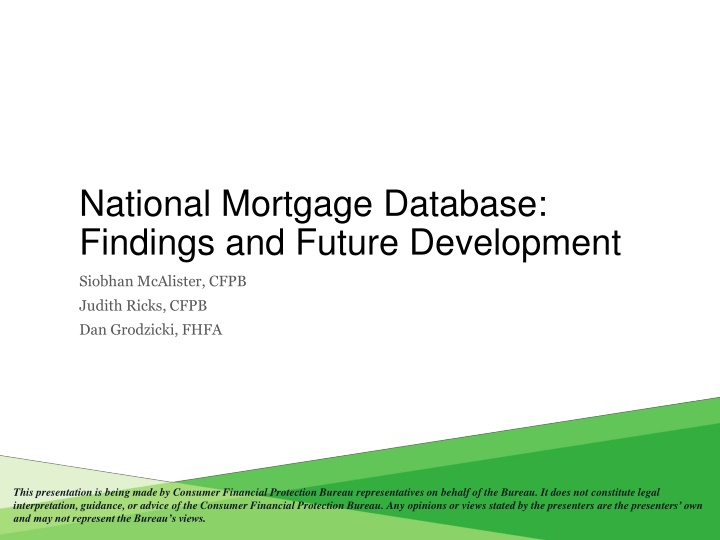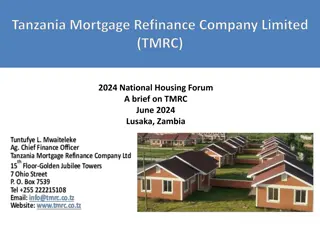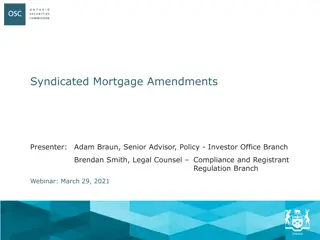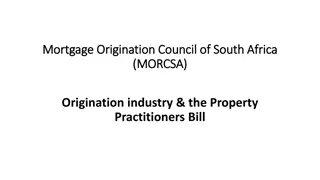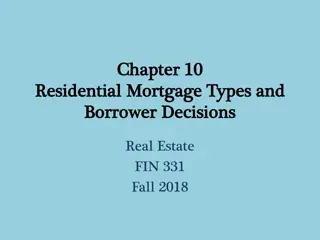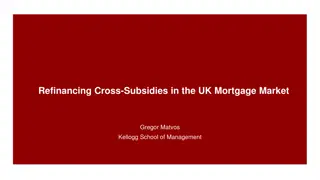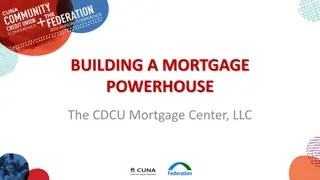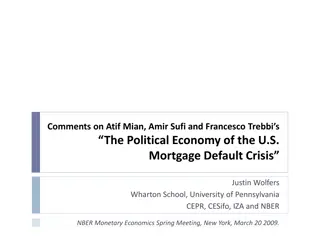National Mortgage Database: Findings and Future Development
The National Mortgage Database (NMDB) is a representative survey of closed-end first-lien residential mortgages in the United States, jointly funded by FHFA and CFPB. It comprises surveys such as the National Survey of Mortgage Originations (NSMO) and American Survey of Mortgage Borrowers (ASMB), providing extensive loan information and borrower characteristics. The database includes data from various sources like HMDA, Fannie Mae, Freddie Mac, VA, FHA, and RHS, offering insights into mortgage terms, property characteristics, and more. The NSMO, a quarterly survey, delves into borrower perceptions, mortgage shopping behavior, consumer knowledge, demographics, and satisfaction. The NMDB plays a crucial role in understanding the mortgage landscape and informing future developments in the industry.
Download Presentation

Please find below an Image/Link to download the presentation.
The content on the website is provided AS IS for your information and personal use only. It may not be sold, licensed, or shared on other websites without obtaining consent from the author.If you encounter any issues during the download, it is possible that the publisher has removed the file from their server.
You are allowed to download the files provided on this website for personal or commercial use, subject to the condition that they are used lawfully. All files are the property of their respective owners.
The content on the website is provided AS IS for your information and personal use only. It may not be sold, licensed, or shared on other websites without obtaining consent from the author.
E N D
Presentation Transcript
National Mortgage Database: Findings and Future Development Siobhan McAlister, CFPB Judith Ricks, CFPB Dan Grodzicki, FHFA This presentation is being made by Consumer Financial Protection Bureau representatives on behalf of the Bureau. It does not constitute legal interpretation, guidance, or advice of the Consumer Financial Protection Bureau. Any opinions or views stated by the presenters are the presenters own and may not represent the Bureau s views.
National Mortgage Database (NMDB) Representative 1-in-20 sample of all closed-end first-lien residential mortgages in the United States Jointly funded by FHFA and CFPB NDMB Program has three components: NMDB 2 Surveys: National Survey of Mortgage Originations (NSMO) American Survey of Mortgage Borrowers (ASMB) 2
NMDB Sample Sample is drawn from credit records Mortgages in the sample are merged with other datasets including: Home Mortgage Disclosure Act (HMDA) Data Median Borrower income, Application Denial Rate, Median Loan Amount, Percent of Borrowers by Race Administrative data from Fannie Mae, Freddie Mac, VA, FHA, and RHS Date loan entered an Enterprise, Acquisition Date, Loan Type (Conventional, VA, FHA, FSA/RHS) Proprietary data 3
What is in the NMDB? Each loan record is matched with an extensive amount of information, including: loan type, product type, mortgage terms property characteristics borrower characteristics for each borrower on the loan from administrative data monthly loan performance nonmortgage debt information 4
NMDB Surveys Two surveys sampled from the NMDB: National Survey of Mortgage Originations (NSMO) and American Survey of Mortgage Borrowers (ASMB) Data from both surveys can be merged at the loan level to the administrative data in NMDB Flexibility in the construction of the survey instrument for both NSMO and ASMB 5
National Survey of Mortgage Originations (NSMO) Quarterly survey of sample drawn from NMDB of newly originated mortgages Most recent questionnaire (2024, Q2) Topics: Borrower perceptions and experiences Mortgage Shopping Consumer Knowledge Expectations Demographics Life events Satisfaction 6
American Survey of Mortgage Borrowers (ASMB) Annual survey of sample drawn from NMDB, oversampled based on characteristics of interest Similar set of questions year-to-year with added topical questions Experiences managing a mortgage Responding to financial stressors Insuring against risks Most recent questionnaire (2023) Special topics 2020 Mortgage Forbearance 2022 COVID-19 2023 Flood Risk 2024 High interest rates/Lock-in, Escrow 7
Survey Benefits Samples come from NMDB so results can be linked to base data set We can adjust questions to timely topics ASMB focus areas Collaboration begins a year in advance with FHFA Useful for surveying consumers for whom there exists little information Certain NSMO quarters have over sampled rural consumers 8
Policy Work Using NMDB Fulfill statutory requirements: the Mortgage Performance Trends website partially fulfills Dodd-Frank Act Section 1447 Rulemakings and Assessments: ATR/QM, TRID, Mortgage Servicing Market monitoring 9
Research using NMDB NMDB (and surveys) are unique relative to other data used by researchers More origination details plus credit performance over time compared to HMDA Demographics are more accurate than proprietary datasets (e.g., CRISM) Sample sizes: NMDB: ~ 14.5 million loans NSMO: ~ 45,000 loans ASMB: ~ 1,300 per survey year 10
1. Example 1: Single Borrower Characteristics Preliminary work by Conell-Price and Ricks (Office of Research) In HMDA and NMDB, roughly 45% of loan originations come from single borrowers as opposed to joint borrowers Joint borrower loans require underwriting for two (or more) borrowers, while single borrower loans only underwrite one borrower It s not necessarily the case that single borrower loans correspond to true single heads of household (i.e., unmarried or not financially partnered) Who are single borrowers? 11
NMDB vs. NSMO: Who are single borrowers? NMDB NSMO Male Female Male Female mean/se 87.60 [0.13] mean/se 93.36 [1.02] Income (thousands of dollars) 71.23 [0.10] 73.35 [0.78] Age 41.79 [0.02] 45.08 [0.02] 47.08 [0.18] 49.05 [0.21] Debt-to-income (DTI) ratio 36.54 [0.02] 37.72 [0.02] 37.05 [0.15] 38.17 [0.18] Vantage Score 722.79 [0.09] 726.13 [0.12] 734.11 [0.86] 734.24 [1.01] Observations Percent 493,348 60.22 325,915 39.78 5,588 56.13 4,367 43.87 Note: Summary statistics for single borrowers in NMDB and NSMO data. These statistics are preliminary and subject to change. They should not be referenced without consultation from the authors. 12
NMDB vs. NSMO: Who are single borrowers? NMDB NSMO Male Female Male Female mean/se 87.60 [0.13] mean/se 93.36 [1.02] Income (thousands of dollars) 71.23 [0.10] 73.35 [0.78] Age 41.79 [0.02] 45.08 [0.02] 47.08 [0.18] 49.05 [0.21] Debt-to-income (DTI) ratio 36.54 [0.02] 37.72 [0.02] 37.05 [0.15] 38.17 [0.18] Vantage Score 722.79 [0.09] 726.13 [0.12] 734.11 [0.86] 734.24 [1.01] Share financially partnered ? ? 56.21 [0.01] 23.56 [0.01] Observations Percent 493,348 60.22 325,915 39.78 5,588 56.13 4,367 43.87 Note: Summary statistics for single borrowers in NMDB and NSMO data. These statistics are preliminary and subject to change. They should not be referenced without consultation from the authors. 13
NSMO: Who are financially partnered borrowers? Male Female Financial status: Unpartnered Partnered Unpartnered Partnered Income (thousands of dollars) 80.79 [1.47] 739.62 [1.26] 0.76 [0.01] 0.08 [0.01] 0.10 [0.01] 0.03 [0.00] 0.03 [0.00] 0.19 [0.01] 2,447 43.79 103.15 [1.39] 729.82 [1.17] 0.70 [0.01] 0.07 [0.00] 0.11 [0.01] 0.09 [0.01] 0.03 [0.00] 0.57 [0.01] 3,141 56.21 69.38 [0.76] 735.68 [1.15] 0.72 [0.01] 0.13 [0.01] 0.08 [0.00] 0.03 [0.00] 0.03 [0.00] 0.24 [0.01] 3,338 76.44 86.20 [2.13] 729.57 [2.12] 0.66 [0.01] 0.12 [0.01] 0.11 [0.01] 0.08 [0.01] 0.03 [0.01] 0.48 [0.02] 1,029 23.56 Vantage Score Share White-non-Hispanic Share Black-non-Hispanic Share Hispanic Share Asian Share other race Reported dependents under 18 Observations Percent Note: Sample of NSMO borrowers. Mean and standard error reported. These statistics are preliminary and subject to change. They should not be referenced without consultation from the authors. 14
NSMO: Who are financially partnered borrowers? Male Female Financial status: Unpartnered Partnered Unpartnered Partnered Income (thousands of dollars) 80.79 [1.47] 739.62 [1.26] 0.76 [0.01] 0.08 [0.01] 0.10 [0.01] 0.03 [0.00] 0.03 [0.00] 0.19 [0.01] 2,447 43.79 103.15 [1.39] 729.82 [1.17] 0.70 [0.01] 0.07 [0.00] 0.11 [0.01] 0.09 [0.01] 0.03 [0.00] 0.57 [0.01] 3,141 56.21 69.38 [0.76] 735.68 [1.15] 0.72 [0.01] 0.13 [0.01] 0.08 [0.00] 0.03 [0.00] 0.03 [0.00] 0.24 [0.01] 3,338 76.44 86.20 [2.13] 729.57 [2.12] 0.66 [0.01] 0.12 [0.01] 0.11 [0.01] 0.08 [0.01] 0.03 [0.01] 0.48 [0.02] 1,029 23.56 Vantage Score Share White-non-Hispanic Share Black-non-Hispanic Share Hispanic Share Asian Share other race Reported dependents under 18 Observations Percent Note: Sample of NSMO borrowers. Mean and standard error reported. These statistics are preliminary and subject to change. They should not be referenced without consultation from the authors. 15
NSMO: Who are financially partnered borrowers? Male Female Financial status: Unpartnered Partnered Unpartnered Partnered Income (thousands of dollars) 80.79 [1.47] 739.62 [1.26] 0.76 [0.01] 0.08 [0.01] 0.10 [0.01] 0.03 [0.00] 0.03 [0.00] 0.19 [0.01] 2,447 43.79 103.15 [1.39] 729.82 [1.17] 0.70 [0.01] 0.07 [0.00] 0.11 [0.01] 0.09 [0.01] 0.03 [0.00] 0.57 [0.01] 3,141 56.21 69.38 [0.76] 735.68 [1.15] 0.72 [0.01] 0.13 [0.01] 0.08 [0.00] 0.03 [0.00] 0.03 [0.00] 0.24 [0.01] 3,338 76.44 86.20 [2.13] 729.57 [2.12] 0.66 [0.01] 0.12 [0.01] 0.11 [0.01] 0.08 [0.01] 0.03 [0.01] 0.48 [0.02] 1,029 23.56 Vantage Score Share White-non-Hispanic Share Black-non-Hispanic Share Hispanic Share Asian Share other race Reported dependents under 18 Observations Percent Note: Sample of NSMO borrowers. Mean and standard error reported. These statistics are preliminary and subject to change. They should not be referenced without consultation from the authors. 16
NSMO: Distribution of Loan Amount by Financial Partnered Status Note: Sample of NSMO loans. Loan amount (in thousands) reported on x-axis. Figure reports inter-quartile range of loan amount. Loan amount top-coded at 99th percentile. These statistics are preliminary and subject to change. They should not be referenced without consultation from the authors. 17
NSMO: Distribution of Loan Amount by Financial Partnered Status Note: Sample of NSMO loans. Loan amount (in thousands) reported on x-axis. Figure reports inter-quartile range of loan amount. Loan amount top-coded at 99th percentile. These statistics are preliminary and subject to change. They should not be referenced without consultation from the authors. 18
Financial partnered status Financial partnered status is one measure that generates significant differences in borrower and loan characteristics in the raw data Still more work to be done to better understand the role of financially partnered status Other dimensions that may matter and are typically unobserved: Households with dependents Education level Financial risk-taking 19
2. Mortgage familiarity Preliminary work by Conell-Price (Office of Research) How does mortgage familiarity vary across borrower types (e.g., demographic characteristics)? Descriptive (non-causal) understanding of differences in mortgage familiarity Goal: Develop a measure of mortgage familiarity that serves as a proxy for financial knowledge 20
NSMO: Mortgage familiarity The familiarity index is a composite score defined using a set of seven items on mortgage familiarity: 21
NSMO: Mortgage familiarity The familiarity index is a composite score defined using a set of seven items on mortgage familiarity The composite score totals the number of mortgage concepts out of seven that the respondent reported being very familiar with when they began the process of getting their loan Mortgage familiarity - integer value [0,7] Sample: NSMO (2012-2020) respondents with single-unit, site-built, fixed rate, owner-occupancy loans with terms of at least 10 years. 22
NSMO: Mortgage familiarity Notes: The familiarity index is defined using a set of seven items on mortgage familiarity. The score indicates the number of mortgage concepts out of seven that the respondent reported being very familiar with when they began the process of getting their loan (e.g., The different types of mortgages available ). Sample of NSMO loans Familiarity index is standardized to mean zero, standard deviation 1 and regression-adjusted by loan and borrower characteristics (loan purpose, loan term, loan type, credit score, LTV, month-year of origination, income, age category, financial partner status, and college). These statistics are preliminary and subject to change. They should not be referenced without consultation from the authors. 23
NSMO: Mortgage familiarity Very satisfied received loan with the best terms to fit their needs Notes: The familiarity index is defined using a set of seven items on mortgage familiarity. The score indicates the number of mortgage concepts out of seven that the respondent reported being very familiar with when they began the process of getting their loan (e.g., The different types of mortgages available ). These statistics are preliminary and subject to change. They should not be referenced without consultation from the authors. 24
Mortgage familiarity The preliminary mortgage familiarity index is an example of how the NSMO data can be used to understand borrower experiences during the mortgage origination process. Other descriptive dimensions of analysis include, e.g.: Financial priorities Hierarchy of borrower decision-making Risk profiles 25
Other research using the NMDB, NSMO, or ASMB Data Point: Servicer Size in the Mortgage Market (Critchfield, Durbin, and Russel) Market Snapshot: First-Time Homebuyers (Wong and Herman) Characteristics of Mortgage Borrowers During the COVID-19 Pandemic (Durbin, Li, Low, and Ricks) (and follow up report) What Triggers Mortgage Default? (Low) A Look at Cash-Out Refinance Mortgages and their Borrowers Between 2013 and 2023 (Alexandrov, Cohen-Harding, and Lapid) 26
CFPB ARC Meeting Daniel Grodzicki June 7, 2024 Disclaimer: Comments are provided to stimulate discussion and critical comment. The analysis, conclusions, and any views expressed are those of the author alone and should not be interpreted as conveying an official FHFA analysis, opinion, or endorsement. Any errors or omissions are the sole responsibility of the author. NMDB S NEXT STEPS FORWARD
Administrative Data HMDA Data Credit Bureau Data National Mortgage Database (NMDB)
Property Matching Panel Development Non-Mortgage Data Third Party Matching
THANK YOU! D I S C U S S A N T C O M M E N T S 31
